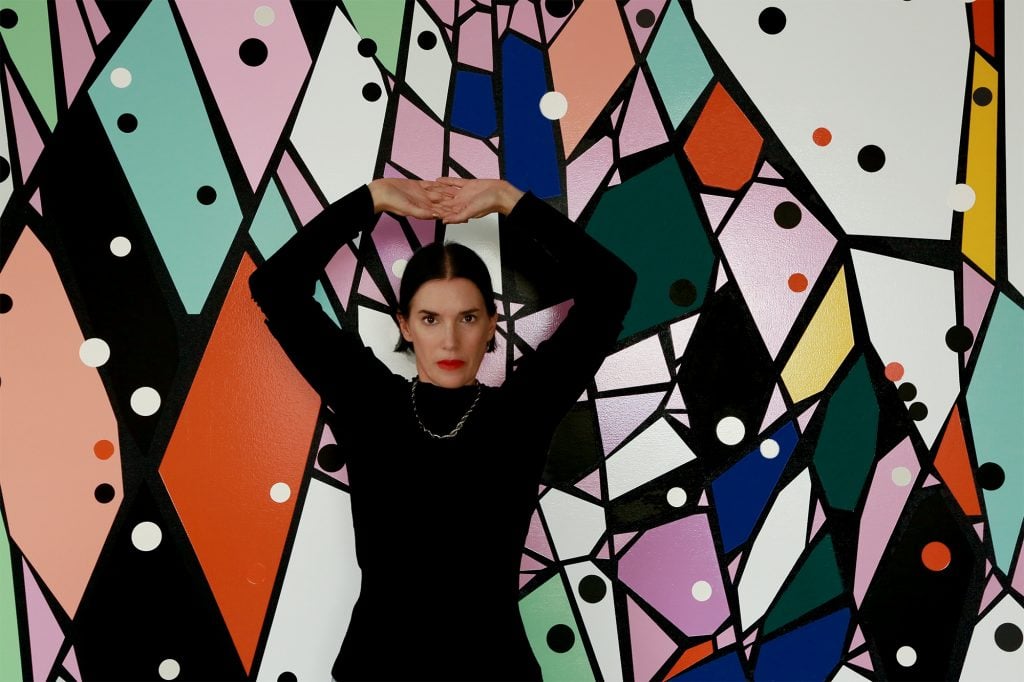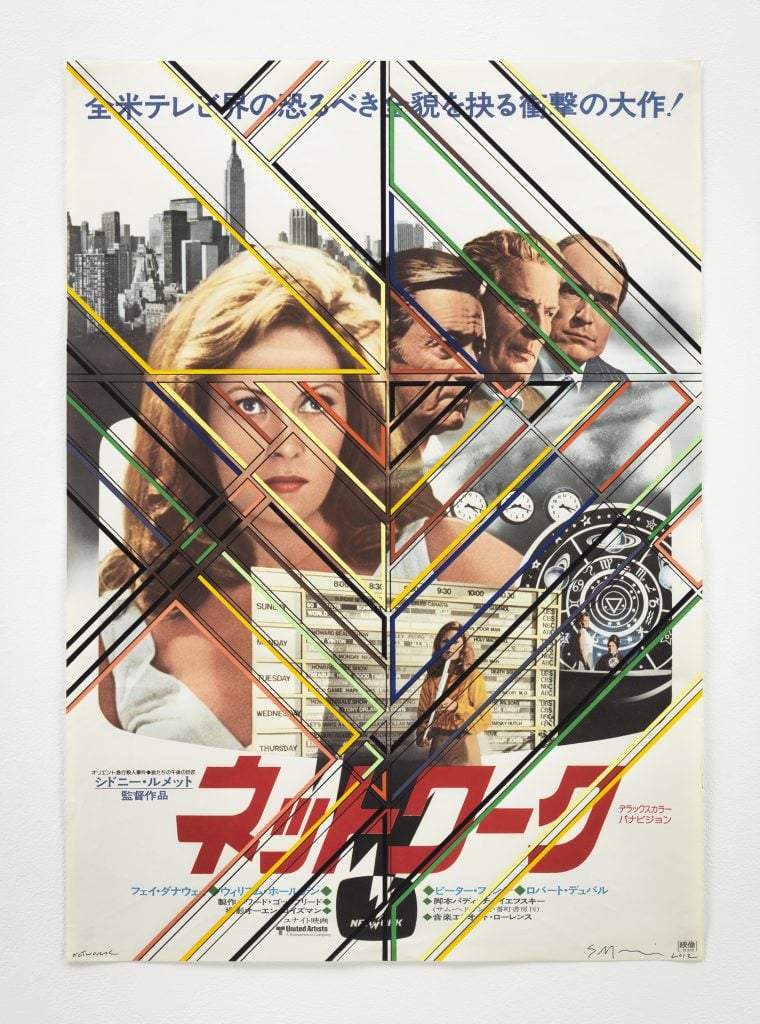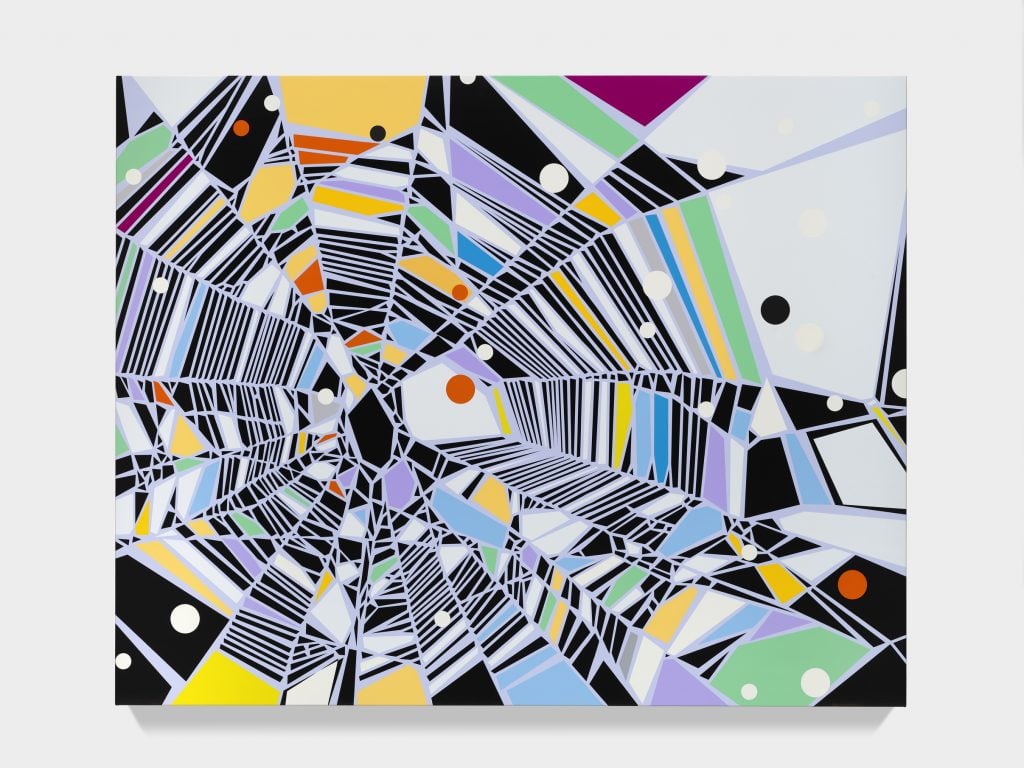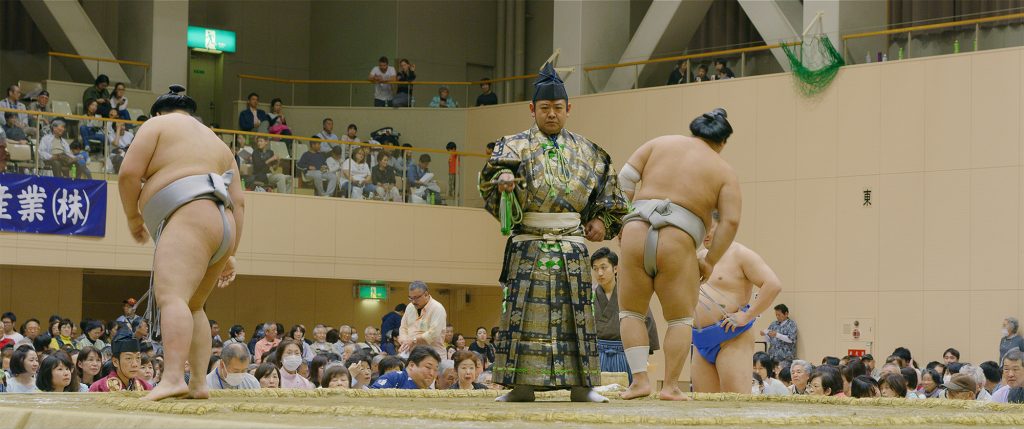Gallery Network
‘There’s a Lot of Ingenuity in These Little Forms’: Artist Sarah Morris on Why She Started Painting Spiderwebs During Lockdown
The artist's most recent works are now on view in "Means of Escape" at White Cube Gallery.

The artist's most recent works are now on view in "Means of Escape" at White Cube Gallery.

Katie White

British-American artist Sarah Morris sees systems of connection—metro networks, city plans, spiderwebs—everywhere she looks. Since the mid-1990s, Morris has honed a visual language of geometric, color-blocked paintings and installations that derive from the man-made structures and systems of cities around the world. She devotes entire series to individual locations (Los Angeles, Midtown Manhattan, Washington D.C., Beijing… the list goes on) and ponders the public transportation, architecture, and industries. She makes films, too—atmospheric and vaguely suspenseful montages of the cities, which hint at the infinite experiences occurring within them.

Sarah Morris, Network (2021). Courtesy of White Cube Gallery.
When the world went into lockdown in 2020, Morris was in the middle of a project focused on Hong Kong. Usually jet-setting around the globe, Morris went into quarantine in rural Massachusetts and her macro view became decidedly microscopic: spiderwebs strung in house corners, trees, and unexpected nooks-and-crannies became the objects of her fascination.
The paintings she made in this period—a series called “Spiderwebs”—are currently on view in her exhibition “Means of Escape” at White Cube Gallery, London. Morris recently spoke to us about how the pandemic has changed her understandings of cities, time, and perception itself.

Sarah Morris, Patrol (Spiderweb) (2021). Courtesy of White Cube Gallery.
Your new series “Spiderwebs” looks often like color-filled webs or radial cracks on a frozen lake or pane of glass. Can you tell me a bit about the series and how it came about?
I had left the city as it went into lockdown in the woods in Massachusetts. The first painting I made from that time is called Dilemma. During this time, I had started to think about scale in relationship to the city. On one hand, the density of the population was a source of concern with the pandemic. On the other hand, the city was suddenly seemed abandoned.
At the same time, I had become more aware of the details in my own new environments, and I had been fascinated with the spiderwebs I kept seeing and their constructions, their improvisation, and their sort of ingenuity. I was taking a lot of photographs of these webs and thinking about this micro scale. Suddenly I saw the city as an organic entity—yes, it’s man-made, but it’s organic in the sense that it’s permeable and vulnerable. Like any other structure on the earth, it can just be suddenly be gone or extremely imperiled. A city is a fragile form, an ephemeral form, that can be emptied out and then congested again or condensed.
What do you see as the similarities between spiderwebs and cities?Spiderwebs are engineered. They’re extremely strong. They’re predatory. They’re also a habitat. And yet they can suddenly disappear; they appear overnight, they disappear, things run through them. They continue. The wind blows and they change again.
I see the paintings as a sort of a modality of how you think about the perception of time, the city, and the disorientation all around us. Typically, I’m looking at the macro—New York, Las Vegas, Miami, Beijing—and how these chains of cities are interconnected. Places are linked to other places and it’s impossible to isolate them, not because of globalization, but just because of the history of civilization.
These web structures became diagrams in a way—I’m using them in a very loose form—as a way of looking at the situation we were in and the spatial disorientation around us.
This micro-structure has everything. Maybe, I thought, it has some properties that one could think about. There’s a lot of ingenuity in these little forms. People brush them away, but actually they’re absolutely necessary for an entire chain of existence. There is no place that is not linked to another place, right? What’s going on in South Africa is related to London is related to New York.

Film still of Sakura by Sarah Morris. Courtesy of White Cube Gallery.
Your film Sakura, which you finished before the pandemic, is also on view in the exhibition. Can you tell me about the film?
I made Sakura in Japan in 2018. Many of my films are very specifically timed around an event, whether it’s the Beijing 2008 Olympics or the end of the Clinton administration at the Capitol. This film was timed right at the moment the Sakura trees blossom, for about three days. I knew about the blossoming and thought it was extremely beautiful and sort of meaningful, but it turns out it’s a huge tourist attraction. We landed in the Osaka airport and there were throngs of people on a pilgrimage to see those trees bloom. I understand why.
The timing was made even more unpredictable by climate change. Now the trees bloom about three weeks earlier than they used to because of the change in temperature. Ultimately, we got the footage though. With all my films, it’s a bit of an accordion of many different locations and situations, moving in and out across space.
For this film, we shot for instance at Bunraku puppet theater, which was designed by architect Kiro Kurokawa. We also went to the lab of Shinya Yamanaka, who discovered the omnipotent plural stem cell in 2012. There’s also a great scene in a famous cookie factory. Like all of my films, there were about a hundred locations featured. It’s meant to be an A-to-Z in the day in the life of a city—full of non-linear fragments that become this hyper-collage of what could be happening in a place at a single moment.
Have you been able to travel much since the onset of the pandemic? It seems integral to a lot of your work. I know you are meant to be making a film about Hong Kong…
We started filming in Hong Kong just before the pandemic started. That project is on hold at the moment. The quarantine rules are such that they’re very prohibitive to go into Hong Kong. I think it’s a 21-day quarantine. But I have traveled to Europe a couple of times and obviously I went to go install “Means of Escape” at White Cube.
Nevertheless, being mostly locked down you’re caught observing your actual existence, wherever you are, where that happens to be.
Do you think lockdown has affected your work formally—beyond forcing you to look more closely at the immediate environment?
What I would say about the paintings is there’s a growing element of—not disorder—but randomness. Where is the reference? The reference in these paintings is no longer the city, but time itself becoming sort of elastic. We’re not really remembering which day of the week it is—or even how long this has gone on. The word “post-pandemic” is a bit optimistic, in my opinion. I think our realities have shifted under our feet and we’re trying to get a grip on time, but at the same time, we’re highly disoriented.
The hard deadline of this exhibition was actually very good for me—to have a date to work toward. I have a series of lunar works in the exhibition that are my own pandemic diary. Each month, I’ve made a painting that is my interpretation of the lunar calendar. That’s a timestamp of the show in a way. That’s the most solid thing going on the grid of time, the grid of the calendar.